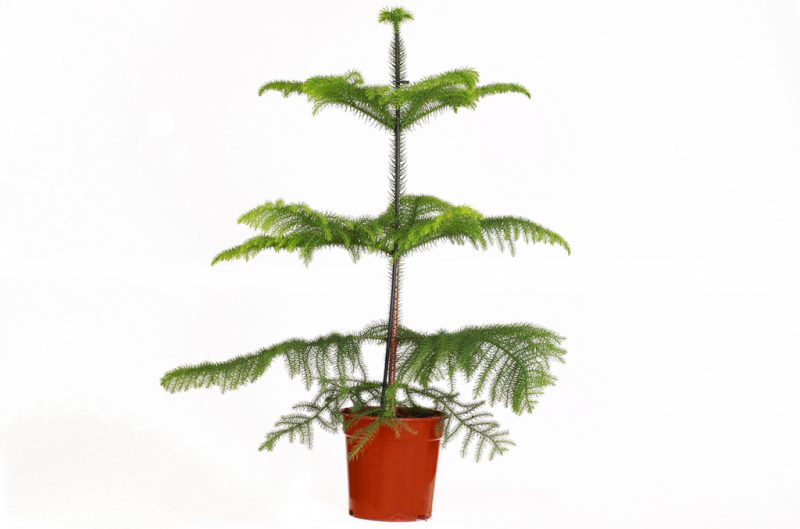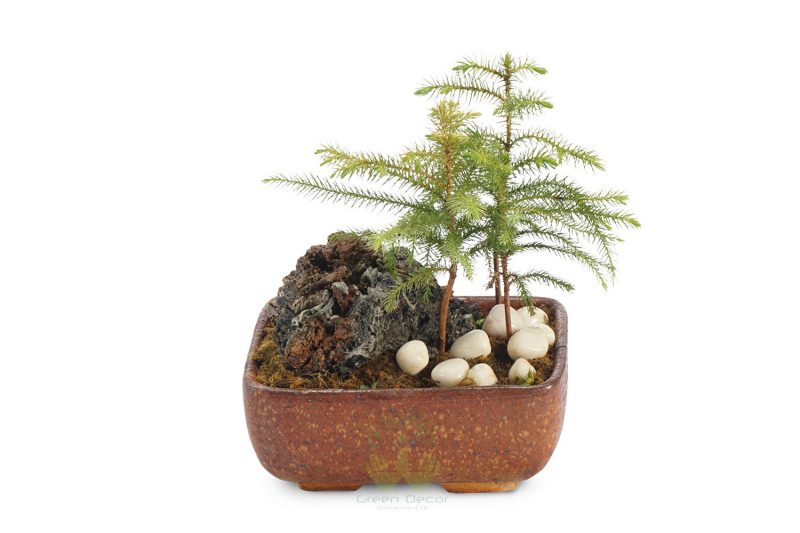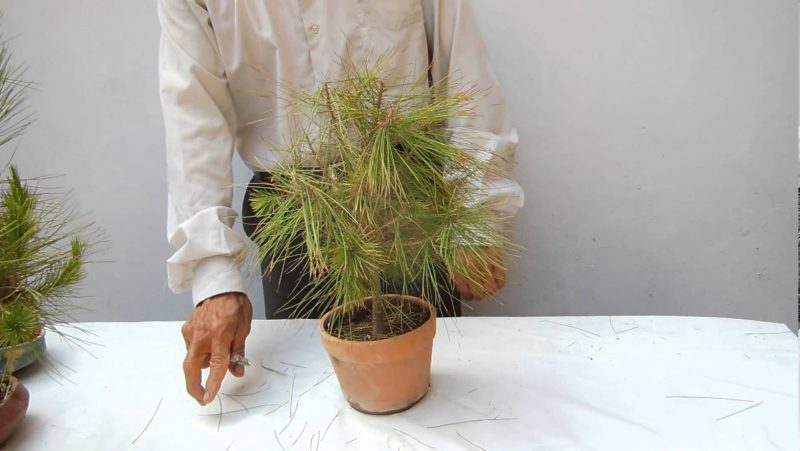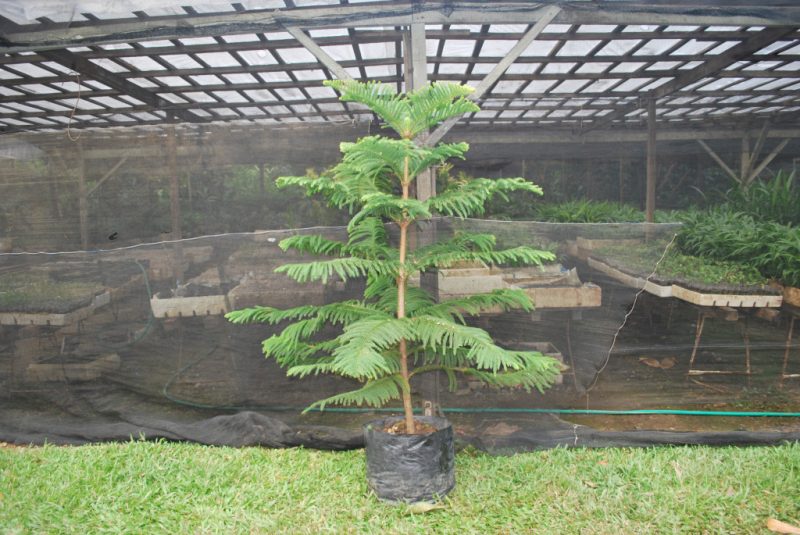Araucaria, or indoor spruce, is an evergreen coniferous plant that can grow at home. In nature, this spruce grows in South America, Australia and New Guinea and can reach 50-60 meters in height. Some specimens live very long, up to 2000 years. In an apartment, it grows to a maximum of 2 m, then, if desired, it can be planted in open ground.
Material Content:
Araucaria - description of a home spruce in a pot
Araucaria is a real house spruce in a pot. Its light green branches extend from the trunk almost at right angles and form an ideal pyramidal crown.

Main characteristics:
- upright trunk;
- thick resinous bark;
- stiff and flat needles located on the branches in a spiral;
- spherical or umbrella-shaped crown;
- ovoid cones.
Araucaria is often used as a Christmas tree.
Varieties and varieties

The most common types and varieties:
- Chilean Araucaria. In nature, grows in Argentina and Chile. This tree can reach 60 m in height. As they age, the lower branches fall off, so the crown becomes like an umbrella. The needles of the Chilean spruce are quite dense and tough, lasting for 12-14 years. There are decorative views with wide golden needles.
- Variegated. The birthplace of the plant is Norfolk Island, near Australia. In nature, grows up to 50 m. It forms a beautiful crown, while the branches have the shape of even triangles. The name spruce received due to the characteristics of the needles. Young needles are soft and thin, have an emerald green color.Subsequently, they become scaly, thicker and denser.
- Narrow-leaved. It is also called Brazilian, as it grows in the southern regions of Brazil, where it reaches 30 m. In greenhouses, the maximum height is 4 m. The needles are thick, spiky, and rich dark green in color.
In room conditions, only variegated araucaria can grow. In the apartment she does not grow more than 1.5 m.
Basic growing requirements
If the plant is provided with optimal conditions, it will not hurt and can grow well.

You need to take note of these tips:
- Indoor spruce prefers bright rooms, but can grow in partial shade. The plant does not tolerate direct sunlight, therefore, it must be shaded at noon. In the warmer months, spruce can be taken out onto the street, terrace or balcony.
- In order for the branches to develop and grow evenly, once every 7 days the plant needs to be deployed on the other side to the light. But it is best to put it in a uniformly lit place.
- Araucaria potato does not like heat. The optimum temperature for it, even in the warm season, should not exceed +22 degrees, in winter - +15. It is extremely undesirable to put the plant near heating appliances and radiators.
- The plant must be handled very carefully, being careful not to damage the tip, as there is a growth point. If it is broken off, the spruce will cease to grow up, and the branches will develop unevenly.
The best soil for indoor spruce is weakly acidic, as for all conifers. A good substrate can be prepared independently by mixing deciduous, coniferous and sod land with humus, peat and sand. Spruce also grows well in hydroponics.
Araucaria care at home
Growing araucaria is a simple task. However, in order for the plant to feel good, it needs to ensure normal humidity. Therefore, spruce should be sprayed regularly. Even better, put a container with spruce in a pan filled with wet expanded clay. It is advisable to cover the soil with moss sphagnum, which will retain moisture. Excessive dryness often provokes drying out and yellowing of needles.

Watering should be plentiful, but not frequent. In the hot season, the plant is watered about 1 time every 5 to 7 days, making sure that the earthen lump is completely wet. Residual water flowing into the sump is drained. Araucaria painfully responds to a lack of moisture, so the earthen lump should never be dry.
During the growing season, the plant is fed with fertilizer for conifers 1 time in 3 weeks.
Often transplant spruce is not worth it. Young plants are transplanted once every 3 to 4 years in the spring in more spacious pots. To slow the growth of an adult plant, it is recommended to simply change the soil and plant it in a pot of the same size. Drainage from broken brick, gravel or expanded clay is mandatory, while it must occupy at least ¼ part of the pot.
Reproduction of home spruce
Spruce can be propagated by cuttings or seeds, but the latter method is rarely used, since it is quite laborious. In addition, seedlings grow and develop very slowly. Seeds can be sown in a greenhouse or prepared box with a light substrate. It is advisable to cover the ground with sphagnum so as not to lose moisture. Shoots will appear only after a few months.

For propagation by cuttings, only a plant aged at least 10 years is suitable.
- In July, it is necessary to cut a half-lignified apical cuttings by half (in no case the top).
- Planting material is prepared, dried for 24 hours, then cleaned from resin and planted in a substrate of sand and peat.
- It is advisable to cover the shank with a jar and put in a warm place.
- Rooting does not occur immediately, it takes from 2 to 5 months. To speed up this process, you can use special drugs.
- Young seedlings are transplanted into a substrate for conifers.
Pest and disease protection
Improper care provokes various diseases, so you need to try to create optimal conditions for the araucaria plant.

Drying of an earthen coma and too high air temperature are especially dangerous for spruce.
The most common problems when growing and how to solve them:
- Too slow growth. Thus, an excess of calcium in the soil can manifest itself. Therefore, for feeding, you need to use only special fertilizers with a minimum amount of calcium. Hard water should also not be used.
- Drying of the lower branches of araucaria. This is one of the signs of a root beetle attack. The plant should be urgently treated with an insecticide.
- Too thin branches. This is a sure sign of a lack of nutrients. Feeding should be carried out immediately.
The plant is rarely exposed to pests. Sometimes a mealybug attacks araucaria. It can simply be removed with cotton wool moistened with alcohol.
Possible growing difficulties
If the plant is provided with optimal conditions, no difficulties are foreseen. A sufficient amount of light and moisture is all that is needed for the normal development of spruce.

- Sometimes the owners of araucaria complain of a curvature of the trunk. This is the result of uneven lighting. A container with a plant simply needs to be regularly turned in different directions to the light.
- If the shoots dry out and turn yellow, the cause is dry air, inadequate humidity, or poor watering. The plant should be sprayed regularly, increasing the humidity in the room, and increase watering. For this reason, needles may fall.
But if you create comfortable conditions for Araucaria, it will delight the owner with lush greenery for a long time. Among other things, it is not only a beautiful ornamental plant, but also a natural orderly. It releases beneficial phytoncides, which purify the air and destroy harmful microorganisms and bacteria.












